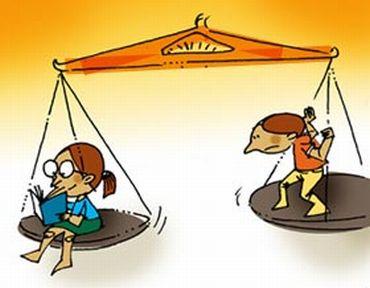Data Interpretation questions typically have large amounts of data given in the form of tables, pie-charts, line graphs or some non-conventional data representation format.
The questions are calculation heavy and typically test your approximation abilities. A very large number of these questions check your ability to compare or calculate fractions and percentages. If you sit down to actually calculate the answer, you would end up spending more time than required. Here are few ideas that you can use for approximation.
Funda 1: Calculating (Approximating) Fractions
When trying to calculate (approximate) a fraction 'p/q', add a value to the denominator and a corresponding value to the numerator before calculating (approximating).
Example,
What is the value of 1789/762 ?
First the denominator. We can either take it close to 750 or to 800. Let's see how it works in both cases. We know that the answer is between 2 and 3, so for adding values / subtracting values from the denominator or the numerator, I will consider a factor of 2.5.
Case 1
762 is 12 above 750, so I will subtract 12 from the denominator. Keeping the factor of 2.5 in mind, I will subtract 25 from the numerator.
My new fraction is,
(1789 – 25) / (762 – 12) = 1763 / 750 = 1763 x (4 / 3000 ) = 7.052 / 3 = 2.350666
Actual answer is 2.34776.
As you can see, with very little effort involved in approximation, we arrived really close to the actual answer.
Case 2
762 is 38 below 800, so I will add 38 to the denominator. Keeping the factor of 2.5 in mind, I will add 95 to the numerator.
My new fraction is,
(1789 + 95) / (762 + 38) = 1884 / 800 = 2.355
As you can see, even this is close to the actual answer. The previous one was closer because the magnitude of approximation done in the previous case was lesser.
Illustration: Uttam Ghosh
How to compare fractions
Funda 2: Comparing Fractions
If you add the same number to the numerator and denominator of a proper fraction, the value of the proper fraction increases.
If you add the same number to the numerator and denominator of an improper fraction, the value of the improper fraction decreases.
Note: You can remember this by keeping in mind that,
1/2 < 2/3 < 3/4 < 4/5 ...
and
3/2 > 4/3 > 5/4 > 6/5 ...
Example,
Arrange the following in increasing order: 117/229, 128/239, 223/449.
Let's first compare 117/229 & 128/239.
If we added 11 to the numerator and the denominator of the first proper fraction, the resulting proper fraction would be 128/240, which will be bigger in value than the original (as per Funda 2).
We know that 128/240 is smaller than 128/239, as the latter has a lower base.
So, 117/229 < 128/240 < 128/239
→ 117/229 < 128/239
Now let's compare 117/229 and 223/449.
If we added 11 to the numerator and the denominator of the second proper fraction, the resulting proper fraction would be 234/460, which will be bigger in value than the original.
If we doubled the numerator and denominator of the first proper fraction, the resulting proper fraction would be 234/458.
We know that 234/460 is smaller than 234/458, as the latter has a lower base.
So, 223/449 < 234/460< 234/458
→ 223/449 < 117/229
Using the above two results, we can say that 223/449 < 117/229 < 128/239
Note: This question can be solved much simply by just looking at the numbers and approximately comparing them with ½. I used this long explanation to illustrate the funda given above.
Following are a few other shortcuts that might come in handy during DI-related calculations.
Illustration: Dominic Xavier
How to solve percentage problems
If the percentage growth rate is 'r' for a period of 't' years, the overall growth rate is approximately: rt + t (t-1) r2 / 2
Note: Derived from the Binomial theorem, this approximation technique works best when the value of 'r' is small. If the rate is above 10%, then this approximation technique yields bad results. Also, if the rate is 5% then r = 0.05; if the rate is 7.2% then r = 0.072.
Illustration: Dominic Xavier
How to compare numbers
Funda 4: Comparing Powers
Given two natural numbers a and b such that a > b > 1,
ab will always be less than ba
Note: There are only two exceptions to this funda. I hope someone in the comments will point them out (anyone?).
Illustration: Uttam Ghosh






Comment
article